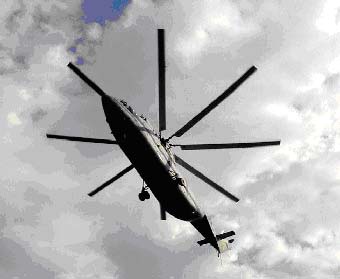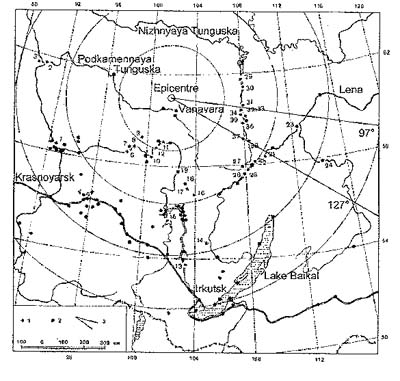Mem. S.A.It, 2002, vol. 73, n. 3, pp. 679-683
A MAIN BELT ASTEROID: THE MOST PROBABLE
CAUSE OF THE TUNGUSKA EVENT
T.J. JOPEK1, R. GONCZI2, CH. FROESCHLЙ2, P. MICHEL2, G. LONGO3, L. FOSCHINI4
1 Obserwatorium Astronomiczne Universytetu A. Mickiewicza, Sloneczna 36, 60286 Poznan (Poland); email: jopek@amu.edu.pl
2 Observatoire de la Cфte d'Azur, Departement Cassini, URA CNRS 1362, B.P. 229, 06304 Nice (France); email: rgonzi, Christiane.Froeschle, michel@obs-nicr.fr
3 Dipartimento di Fisica, Universitа di Bologna, Via Irnerio 46, 40126 Bologna (Italy) and INFN Sezione di Bologna, Via Irnerio 46, 40126 Bologna (Italy); email: Giuseppe.Longo@bo.infn.it
4 Istituto TeSRE—CNR, Via Gobetti 101, 40129 Bologna (Italy); email: foschini@tesre.bo.cnr.it
ABSTRACT. We studied the available scientific literature on the Tunguska event of 30 June 1908 to select a sample of atmospheric trajectories. Then we calculated a set of parameters from which we obtained 886 orbits. Using the method of Bottke and colleagues, based on dynamical properties of celestial bodies, we estimated the probabilities of different origins of the Tunguska Cosmic Body (TCB). Even though 6 of 886 orbits can be both asteroidal or cometary, the probability of an asteroidal origin remains the highest.
1. Aim of the work
Up to now, no experimental data have permitted to definitly discriminate between an asteroidal or a cometary nature of the Tunguska Cosmic Body (TCB), which explosion devastated the 30 June 1908 about 2000 km2 of Siberian taiga (see Di Martino et al. 1998).
To give an answer about the origin of the TCB and a contribution to the international research programs aiming at the study of cosmic impacts with the Earth, an Italian expedition (Tunguska99) was carried out in July 1999 (see Armaroli et al. 2000; see also http://www-th.bo.infn.it/tunguska/ and Fig. 1). Tunguska99 was the best-equipped expedition to the explosion site of the last 40 years. It differed from the previous ones by the fact that the investigations were performed simultaneously by water means, by ground means and by aerial remote sensing.
That field research can be strengthened by theoretical studies and modeling and the present work is a step in this direction. A comprehensive study of the available literature has been carried out, together with modeling of the dynamics of the TCB in the Earth atmosphere. A set of possible orbits has been calculated and the interplanetary dynamic of the TCB has been studied in order to exclude, from a dynamic point of view, some of the trajectories proposed.
The calculations here presented can help choosing between an asteroidal or a cometary origin of the TCB.

Fig. 1: The MI-26 helicopter rented by the Tunguska99 Expedition.
2. Calculations
Starting from objective data and testimonies on the Tunguska event and introducing parameters calculated by modeling, we selected a range of meaningful atmospheric trajectories for the Tunguska Cosmic Body. Then, they were divided into two main groups, commonly referred in literature as typically asteroidal (type I) or typically cometary (type II) (see Table 1 and Fig. 2).
| Time (UTC) |
30 JUNE 1908, 00h 14m 28s |
| Location |
60° 53’ 09’’ N, 101° 53’ 40’’ E |
| Type | Parameters | Preatmospheric | Geocentric |
|
(I) |
Azimuth |
97° ч 127° |
97.1° ч 127.6° |
|
Inclination |
3° ч 5° |
-25.0° ч -12.8° | |
|
Speed [km/s] |
14 ч 16 |
8.0 ч 11.2 | |
|
(II) |
Azimuth |
97° ч 127° |
97.1 ч 127.6° |
|
Inclination |
15° ч 28° |
11.8° ч 25.9° | |
|
Speed [km/s] |
30 ч 32 |
27.6 ч 29.8 |
Table 1: Parameters used in calculations
We kept the azimuth spanning over the whole range of values, i.e. from 97° to 127°, while we reduced the possible values of inclination over the horizon and the incoming speed to two possible sets of values (Table 1).
We then calculated 1120 possible pre—atmospheric orbits of the TCB compatible with the parameters listed in Table 1. From this set we eliminated 30 hyperbolic orbits and 204 orbits with the semi—major axes a > 4.2 AU. The latter selection has been done because the Bottke et al. (2000, 2002) model, used to evaluate the probabilities, does not include bodies with such characteristics. However, each time that it was possible we gave the maximum probability to cometary sources, in order to balance this limit. The result obtained, i.e. 17% probability of a cometary source is compatible with the range of 10—30% of Earth craters coming from nearly isotropic comets population (Shoemaker 1983).

Fig. 2: Map of the region: 1, 2 — witness positions; 3 — selected azimuth range.
The 886 remaining orbits have been analyzed with the help of the Bottke et al. (2000, 2001) model that allows estimating the relative probability that a body on a given orbit (a, e, i) in the NEO region comes from one of the following sources:
S1 - 3:1 mean motion resonance,
S2 - n6 secular resonance,
S3 - Mars—crosser asteroids,
S4 - Outer main belt at a > 2.8 AU and Jupiter family comets.
The results obtained are shown in Table 2. By summing the sources S1, S2, S3 we have the probability of TCB to come from an asteroidal source, while the remaining S4 include all the cometary sources.
|
|
S1 |
S2 |
S3 |
S4 |
Criterion |
| Nє of TCB orbits (%) |
40 |
678 |
21 |
147 |
1 |
| Nє of TCB orbits (%) |
31 |
528 |
11 |
147 (16.6) |
2 |
Table 2: Number and percentage of TCB orbits coming distinctively from each source S1, S2, S3, S4 according to the two criteria of Table 1.
3. Final remarks
We have found that about 83% of the orbits can be reached from a main belt object and that only 17% can be reached from a cometary source. In addition, the atmospheric dynamics suggests that only a body with medium—high mechanical strength could have reached the explosion height of about 8 km. However, it is worth noting that the TCB could be a cross—population object: indeed, there are bodies that behave as asteroids, but are on comet—like orbits, and vice versa. For example, the object 1979 VA is known as the comet 107P/Wilson—Harrington and as the asteroid (4015) Wilson—Harrington (Yeomans 2000).
Presently, taking into account that our sample of orbits is statistically meaningful and more robust than previous studies, we can conclude that our study based on combining interplanetary and atmospheric dynamic considerations gives an asteroidal origin of the TCB as the most probable.
More details of this research can be found in the paper by Farinella et al. (2001).
Acknowledgements
This work originated from an idea of the late P. Farinella, deceased on 25 March 2000. We dedicated it to him. This work has been partially supported by MURST Cofinanziamento 2000.
Refrerences
- Amaroli L., Andreev G., Anfinogenov J., Baskanova T., Benati L., Biasini G., Bonatti E., Cancelli F., Casarini J., Chernikov A., Chernova T., Cocchi M., Deserti C., Di Martino M, Doroshin I., Foschini L., Gasperini L., Grechko G., Kolesnikov E., Kononov E., Longo G., Nesvetajlo V., Palazzo G., Pavlova L., Pipan M., Sacchi M., Serra R., Tsvetkova I., Vasiliev N., Vigliotti L., Zucchini P.: A multidisciplinary investigation in the site of the Tunguska explosion. IX GIFCO: What are the prospects for cosmic physics in Italy?, edited by S. Aiello and A. Blanco. SIF Conference Proceedings 68, Bologna (2000), pp. 113-120.
- Bottke W., Jedicke R., Morbidelli A., Petit J.M., Gladman B. Understanding the Distribution of Near-Earth Asteroids, Science 288, (2000), 2190-2194.
- Bottke W., Morbidelli A., Jedicke R., Petit J.M., Levison H., Michel P., Metcalfe T.S. Icarus (2002), in press.
- Di Martino M., Farinella P., Longo G. (eds): Special issue: Tunguska96, Planetary and Space Science 46, n. 2/3 (1998).
- P. Farinella, L. Foschini, Ch. Froeschlй, R. Gonczi, T.J. Jopek, G. Longo, P. Michel: Probable asteroidal origin of the Tunguska Cosmic Body. Astronomy and Astrophysics 377 (2001) 1081-1097.
- Shoemaker E. M., Asteroid and comet bombardment of the earth. Annu. Rev. Earth Planet. Sci.11, (1983) 461-494.
- Yeomans D.K., Small bodies of the Solar System, Nature 404, (2000), 829-832.
